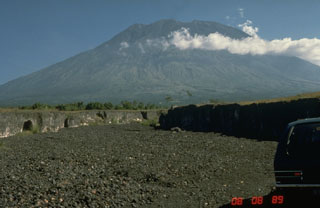Report on Agung (Indonesia) — 4 April-10 April 2018
Smithsonian Institution / US Geological Survey
Weekly Volcanic Activity Report, 4 April-10 April 2018
Managing Editor: Sally Sennert.
Please cite this report as:
Global Volcanism Program, 2018. Report on Agung (Indonesia) (Sennert, S, ed.). Weekly Volcanic Activity Report, 4 April-10 April 2018. Smithsonian Institution and US Geological Survey.
Agung
Indonesia
8.343°S, 115.508°E; summit elev. 2997 m
All times are local (unless otherwise noted)
PVMBG reported that an event at Agung at 1737 on 5 April generated an ash plume that rose 500 m above the crater rim and drifted W. Seismicity was dominated by high- and low-frequency earthquakes. The Alert Level remained at 3 (on a scale of 1-4) and the exclusion zone continued at a 4-km radius.
Geological Summary. Symmetrical Agung stratovolcano, Bali's highest and most sacred mountain, towers over the eastern end of the island. The volcano, whose name means "Paramount," rises above the SE rim of the Batur caldera, and the northern and southern flanks extend to the coast. The summit area extends 1.5 km E-W, with the high point on the W and a steep-walled 800-m-wide crater on the E. The Pawon cone is located low on the SE flank. Only a few eruptions dating back to the early 19th century have been recorded in historical time. The 1963-64 eruption, one of the largest in the 20th century, produced voluminous ashfall along with devastating pyroclastic flows and lahars that caused extensive damage and many fatalities.
Source: Pusat Vulkanologi dan Mitigasi Bencana Geologi (PVMBG, also known as CVGHM)

